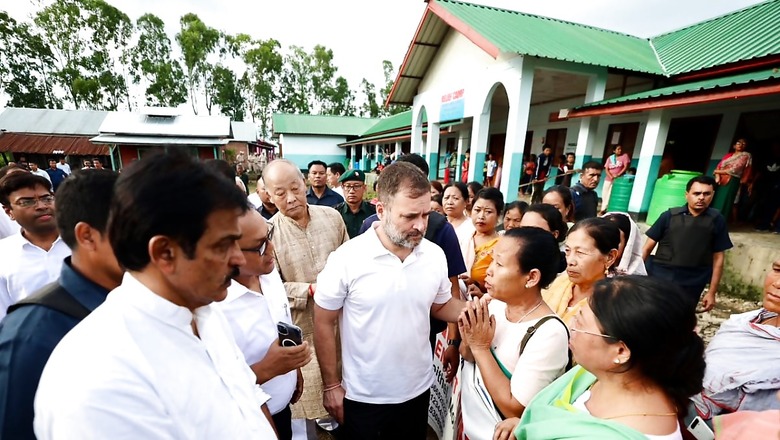
views
It has been more than a year since the ethnic conflict broke out between the Meiteis and Kuki-Zomis in the Northeast state of Manipur. The conflict has taken more than 230 lives with more than 60,000 people still in refugee camps. Recently, Rahul Gandhi, the Leader of the Opposition in the Lok Sabha, visited the state and met with refugees in a camp in Jiribam. It’s worth noting that this was his third visit to the strife-torn state and his first since becoming the LoP.
Being an Opposition leader, it was his duty to visit Manipur, which he did. He also appealed to Prime Minister Narendra Modi to visit the state, which Modi is yet to do. While Modi’s visit alone won’t immediately bring peace, a visit coupled with a clear message addressed to all communities in the state is likely to have a positive impact. Rahul’s visit was a welcome step, as the strife-torn state of Manipur needs attention in the mainstream discussion — so that corridors of power in New Delhi also take the case with more urgency.
Without proper strategies, peace is unlikely
During his visit, Rahul Gandhi aptly pointed out the divisions within the Northeastern state. Following this, the Congress attacked the BJP for neglecting the state. As the main Opposition party, the Congress has a right to criticise the ruling party on the issue of Manipur, especially since the BJP cannot deny its failure to curb the violence.
Having said that, it is also a bitter fact that only talking about Manipur isn’t going to restore normalcy. Until the real causes of this violence are identified, there can’t be any real solutions. Unfortunately, even Rahul Gandhi didn’t talk about the causes, just about the importance of restoring peace. Everyone wants peace, but how can you have it if you don’t deal with the problems that are causing the fighting? The BJP has clearly mishandled the situation, but finding solutions means looking beyond blame and understanding the complex reality.
It is regrettable that Rahul Gandhi, despite visiting the strife-torn Northeastern state three times, showed no interest in talking about the causes of the conflict and possible solutions. The same can be said for Bimol Akoijam, Congress MP from Inner Manipur, whose fiery, emotional speech in the Lok Sabha drew the ruling dispensation’s attention toward Manipur. However, despite all the praise Akoijam deserved for highlighting the pain and suffering of his state’s people in his first speech, it did not focus on the ethnic conflict’s causes nor offer any concrete solutions to restore normalcy.
Issues need to be properly managed
This is not the first time Manipur has witnessed ethnic conflict. In the 1990s, the state saw a similar conflict between the Nagas and the Kuki-Zomis, both communities residing in the hills. Lasting around five years, the conflict resulted in approximately 1,000 fatalities. Other ethnic clashes between different communities also occurred during the 1990s.
This shows that the state is very sensitive where every ethnic community has its own concerns and demands, and very often, these demands clash with the interests of other communities, leading to tensions and, at times, large-scale ethnic conflicts.
For a long time, the Meiteis have been demanding the status of Scheduled Tribe — a concern that even the then-ruling Congress failed to adequately address. While it’s true that the Meiteis hold political dominance in the plains, this representation doesn’t tell the whole story. Lacking Scheduled Tribe status, they are unable to reside in the hills alongside the Nagas and Kuki-Zomis. This restriction significantly impacts the Meiteis, as the hills comprise around 90 per cent of the state’s area, compared to the plains’ mere 10 per cent. While the Meiteis are barred from residing in the hills, both the Nagas and Kuki-Zomis can live in the plains, a disparity that fuels the Meiteis’ demand for Scheduled Tribe status.
This Meitei and Kuki-Zomi conflict isn’t about majority vs minority as the population of Kuki-Zomis has seen a rise over recent decades, while the Meitei population has seen a decline. The Meiteis allege that this demographic shift is partly due to illegal immigration, fuelling their demand for a National Register of Citizens similar to Assam’s. Neither this is a Hindu vs Christian conflict. Not all Meiteis are Hindus; some are Sanamahis, a small section are Christians, and another segment, the Meitei Pangals, are Muslims. The Meitei Pangals have largely remained uninvolved in the current conflict.
But many intellectuals have mischaracterised the situation as a majority-minority conflict, ignoring the fact that both Meiteis and Kuki-Zomis are among the victims. Not only this, despite facts saying otherwise, these intellectuals have even added a religious dimension by blaming Hindutva for the conflict. There is nothing new in these allegations, as for these intellectuals, Hindutva is responsible for every conflict in this country.
Political colours
An often-overlooked aspect is the Naga community’s opposition to the Meiteis’ demand for Scheduled Tribe status. However, Nagas, who are largely Christians, aren’t part of this conflict. The conflict was sparked, in part, by actions of Chief Minister Biren Singh’s BJP-led government that alienated the Kuki-Zomis. One major point of contention was the eviction drives conducted by the Biren government in several Kuki-Zomi-dominated villages. While the government has the right to address illegal settlements and construction on government or reserved forest land, the lack of prior consultation and engagement with the affected communities created resentment. This perceived disregard fuelled a narrative that the government was acting against the interests of the Kuki-Zomis.
It is because of this reason that the Kuki-Zomis have repeatedly, particularly after the ethnic conflict, demanded the resignation of Chief Minister Biren Singh. With time, the discontent among them grew, leading to the present demand of a creation of a state or a Union Territory with a legislature comprising Kuki-Zomi dominated areas of the hills. To be fair, the separation of Manipur is definitely not the solution to bridge this deep ethnic divide.
Biren has also lost the confidence of a section of Meiteis. This became clear after BJP lost the Meitei-dominated Inner Manipur Lok Sabha seat in the recently concluded Lok Sabha polls. Meiteis are unhappy with the Biren government for its inability to protect them in the Kuki-Zomi dominated areas.
Bridging the deep divide
The most important task before the Centre is to initiate peace between the Meiteis and Kuki-Zomis. Obviously, the divide is too deep and it cannot be easily bridged — or may be never — but it can be definitely reduced, if the efforts are genuine and executed in an efficient way. The Centre had earlier formed a 51-member peace committee but it failed before it took off as the Kuki-Zomis objected to the presence of Biren Singh in the committee. On the other hand, Meiteis too were dissatisfied with the committee as they wanted the Centre to withdraw from the Suspension of Operations (SoO) signed with the Kuki-Zomi insurgents. Currently, the Centre is yet to decide regarding the extension of the SoO after it expired in February this year.
Nevertheless, despite the challenges, New Delhi should renew its peace efforts while continuing security operations against both the Meitei and Kuki-Zomi insurgents without any bias or leniency.
Sagarneel Sinha is a political commentator and tweets @SagarneelSinha. Views expressed in the above piece are personal and solely those of the author. They do not necessarily reflect News18’s views.




















Comments
0 comment